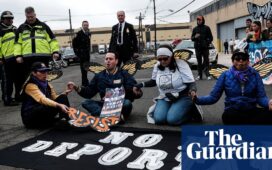In a late Tuesday night email, the administration of New York City’s mayor, Eric Adams, asked a New York supreme court justice to allow it to ignore the state’s longstanding “right to shelter” law in certain circumstances.
Dating back to the Depression, a provision of the New York state constitution stated that “aid, care and support of the needy are public concerns”. A consent decree resolving the 1981 case Callahan v Carey and various lawsuits built on that foundation. Now anyone in New York City can access guaranteed shelter with required minimum standards like 3ft between beds, access to lockers and showers, and basic toiletries. But that 40-year-old law is in jeopardy, amid a push from the city’s executive.
The request comes after weeks of mounting debate about the city’s obligation to serve 100,000 migrants bussed in from the southern border. Earlier this summer, the city struggled to find housing for migrants at an intake center in Midtown Manhattan, with some sleeping on cardboard boxes outside.
That insufficient governmental response to those requiring shelter triggered a Legal Aid Society lawsuit against the city and comments from the state’s top politicians. On 21 September, Kathy Hochul, the state governor, said that the right to shelter was “never meant to house the entire world”. One week later, Adams agreed with a Staten Island judge who called the right “an anachronistic relic from the past”. Then on 1 October, Adams’s chief advisor, Ingrid Lewis-Martin, asked the US government to “close the border”.

The Adams email argued the obligation to house was “demonstrably ill-suited to present circumstances and restrain the city at a time when flexibility to deal with the emergency is paramount”. The city asked to be relieved of the decree’s obligations if the governor or mayor has declared a state of emergency, or when a complicated algorithm concerning the daily number of single adults seeking shelter is “at least 50% greater” than the daily number before the declared state of emergency.
Josh Goldfein, a staff attorney at the Legal Aid Society’s Homeless Rights Project, had been in closed-door talks with the city for weeks.
“The response should be not to just ask to completely gut the consent decree for everyone, new arrivals and longer-term New Yorkers,” Goldfein said in comments on a Zoom call this morning.
He continued: “The formula they proposed is confusing. I’m not sure it’s operable. There are many ways to interpret it, and it is one piece of evidence to show how thoughtless this is. What are we going to do? Set up a counter and when the right number person crosses the line, then suddenly there is no more right to shelter? That seems like not the way to operate a system that is meant to protect human beings from injury and death.”
Rather, what the Legal Aid and other advocates would like to see is more time for new measures to be enacted and have an impact before rolling back such an important right. Hochul proposed a program to aid migrant resettlement throughout the state. And the federal Department of Homeland Security extended Temporary Protected Status to Venezuelans who arrived prior to 31 July, allowing them to skip the 180-day required waiting period before working.
What will happen if the right to shelter is rolled back, even temporarily, in New York City? The law is unique and a national model; only Massachusetts has a right of shelter for families and pregnant women, and Washington DC extends that right during extreme temperatures. Advocates say a look at western cities might provide a sobering glimpse of what could happen.
“There’s a reason why New York City doesn’t have tent encampments, and it’s not that we’re any cheaper than west coast cities,” said Kathryn Kliff, staff attorney for the Legal Aid Society. “Denver, Seattle, San Francisco, Portland, any of those places, you’re going to see a lot of people sleeping out. The reason you don’t see that here is because there is a right to shelter.”
Robert Hayes sees a similar future, with the added component of increased law enforcement activity. As a 26-year-old lawyer in 1979, he argued for the right to shelter in the Callahan v Carey case that established it. His inspiration was conversations with men who were living in Washington Square Park. Those chats took him further afield to the Bowery and the Lower East Side, neglected areas that had then been acting as New York City’s Skid Row. As Hayes tells it, the closing of the psychiatric hospitals and the slow eradication of boarding houses and other low-income housing led to “situations where state psychiatrists were going to Central Park to do psychiatric care to people on benches”.

Now president of the Community Health Network (which operates 14 health centers throughout New York City), Hayes predicts: “Without right to shelter, we’ll have encampments; police actions tearing down encampments which will sprout up around the corner; the subways filled with thousands of people. The quality of life for all New Yorkers, not just those who are homeless, will go to hell in a handbasket.”
After reading the request, Hayes added: “A right, especially a right for disenfranchised people, disappears when the government can declare it’s too hard or there’s too many people or we’re too busy. I think the mayor and the governor are competing for incoherence as a matter of policy.”
Legal Aid has a week to respond to the city’s proposal, and the city also has a week to respond after that. A judge will issue a court schedule later. Meanwhile, another deadline approaches: New York winter is coming along with months of average temperatures below 50F.








